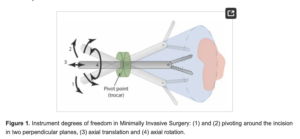
Sponsored by Penn United.
Application breakthroughs in fields from prosthetics to implants to regenerative medicine owe a lot to recent advances in 3D printing. This technology, also referred to as additive manufacturing, is now able to manage increasingly complex geometries, opening the door to applications such as drug delivery devices and smart surgical tools. Traditional surgical tools, commonly constructed from stainless steel and titanium, are exceptionally well-suited to metal 3D printing techniques. It is becoming more feasible to customize surgical tools for a specific procedure or even an individual surgeon.
Laparoscopic graspers, for example, are used in a wide range of procedures – appendectomies, gastric bypass, hernia repair, and biopsies, to name just a few. Performing these operations requires surgeons to access different parts of the body and manipulate different types of tissue or bone. The option to customize the shape of a handle or jaw configuration to a particular procedure, or even an individual surgeon, has the potential to improve outcomes. Because many surgical tools are handheld, lightweighting can help avoid fatigue or discomfort for the surgeon. Smaller, lighter instruments also require less material, reducing costs for the manufacturer as well.

Optimizing design for weight, strength, and performance
The goal of lightweighting is to reduce an object’s weight while maintaining or enhancing its strength and functionality. Topology optimization determines the optimal distribution of materials. This increased precision enables lattice structures, for instance, can be designed to lightweight a particular instrument. Computer-aided design (CAD) software helps engineers throughout the iterative process, from conceptualization to design to optimization. With lattices structures or internal channels, delivery devices, for example, can be optimized to increase performance and efficiency.
The benefits of parts consolidation
Conventional manufacturing offers few opportunities to reduce the number of parts in an application. Instead, processes such as machining and injection molding are used to create individual components, which must then be assembled. 3D printing can create virtually any shape by building an object layer by layer. This allows engineers to combine multiple components into a single part. With fewer components, a tool is lighter, easier to assemble, and often less expensive to produce.
Complex geometries at low costs.

Legacy manufacturing methods such as machining or metal forming have limitations to make highly complex geometries. With metal 3D printing techniques, such as selective laser melting (SLM), complex geometries (often not manufacturable with other technologies) come with little or no impact on cost. The 3D printing process allows engineers to created profiles and geometries for components that can have significant improvements to procedure outcomes. Engineers are now able to design better devices removing the limits of conventional manufacturing processes.
Article Source: MDO









